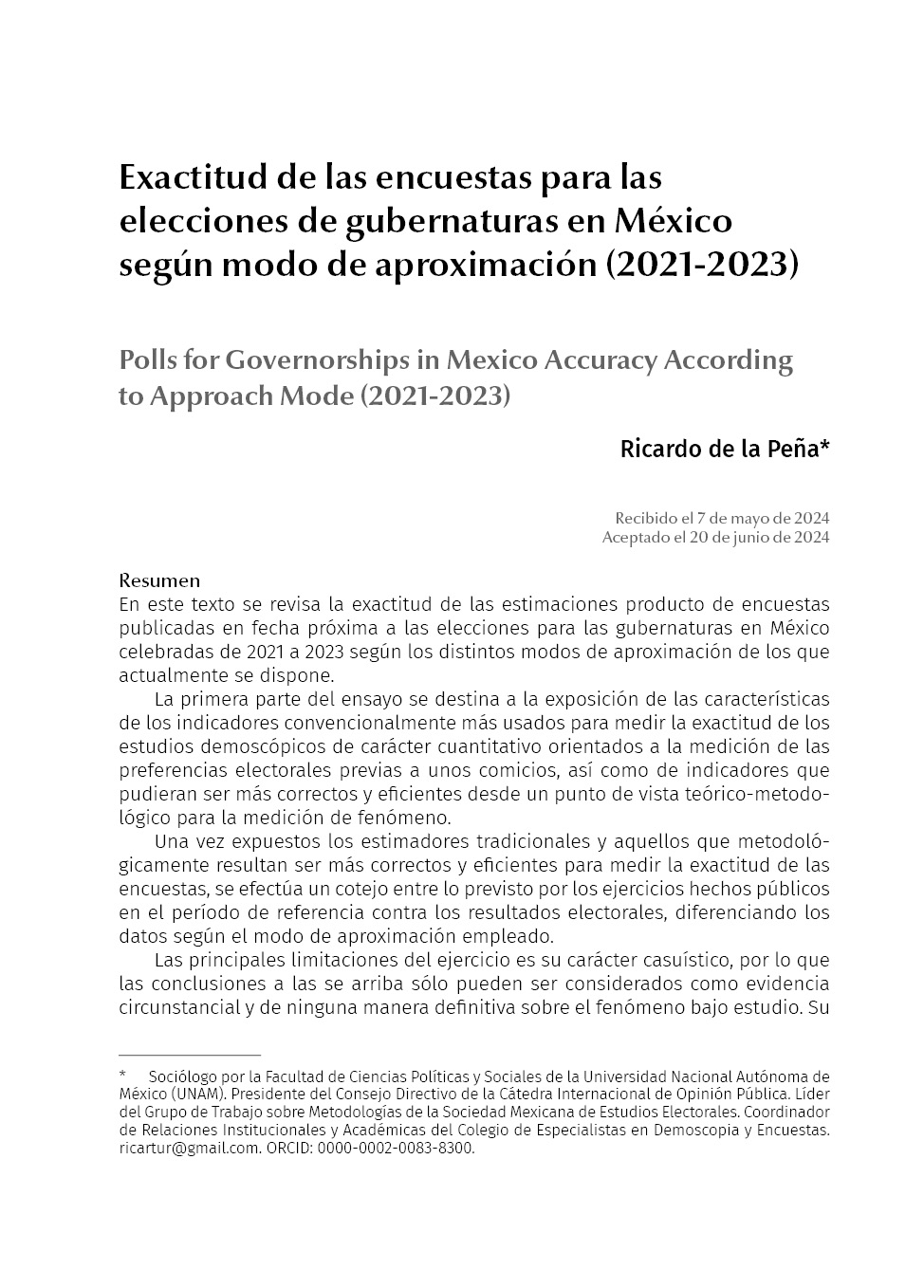Polls for Governorships in Mexico Accuracy According to Approach Mode (2021-2023)
Main Article Content
Abstract
This text reviews the accuracy of the estimates resulting from polls published close to the elections for governors in Mexico held from 2021 to 2023 according to different methods of approximation currently available.
The first part of the essay is dedicated to exposing the characteristics of the indicators conventionally most used to estimate the accuracy of quantitative demoscopic studies aimed at measuring electoral preferences prior to elections, as well as indicators that could be more correct and efficient from a theoretical-methodological point of view for measuring the phenomenon.
Once the traditional estimators and those that methodologically could be more correct and efficient to measure the accuracy of the surveys have been exposed, a comparison is carried out between what was foreseen by the exercises made public in the reference period against the electoral results, differentiating the data according to the approach mode used.
The main limitations of the exercise is its casuistic nature, so the conclusions reached can only be considered as circumstantial evidence and in no way definitive about the phenomenon under study. Its originality, however, lies in the fact that the comparison of differences according to the method of approximation is not usually the way used to analyze the accuracy of the surveys, despite its eventual relevance.
This is confirmed by observing that, as a result of the exercise to estimate the accuracy of the surveys, it is found that this accuracy does depend on the approach method used to carry it out.
Article Details
Citas en Dimensions Service
References
Aitchison, J. (2003). The statistical analysis of compositional data. Blackburn Press.
Redacción AN / GH. (25 de enero de 2021). En México hay 126 millones 014 mil 024 de habitantes: Censo de Población y Vivienda 2020. Aristegui Noticias. https://aristeguinoticias.com/editorial/2501/mexico/en-mexico-hay-126-millones-014-mil-024-de-habitantes-censo-de-poblacion-y-vivienda-2020/
Arzheimer, K. y Evans, J. (2013). A New Multinomial Accuracy Measure for Polling Bias. Political Analysis, 22(1), 31-44. https://www.jstor.org/stable/24573061
CEDE Colegio de Especialistas en Demoscopia y Encuestas-Oraculus. (2023). Observatorio electoral 2023. CEDE.org. http://cede.org.mx/web2016/observatorio-electoral-2023/
CEDE Colegio de Especialistas en Demoscopia y Encuestas-Oraculus (2022). Observatorio electoral 2022. CEDE.org. http://cede.org.mx/ web2016/observatorio-electoral-2022/.
CEDE Colegio de Especialistas en Demoscopia y Encuestas-oraculus.mx (2021). Observatorio electoral 2021. CEDE.org. http://cede.org.mx/ web2016/observatorio-electoral-2021/.
De la Peña, R. (2015). Cómo se mide la exactitud de las encuestas electorales. Política y Cultura, (44), 217-247. http://nbn-resolving.de/urn:nbn:de:0168-ssoar-458895
Instituto Federal de Telecomunicaciones. (2024). Plan Nacional de Numeración. Instituto Federal de Telecomunicaciones. https://sns.ift.org.mx:8081/sns-frontend/planes-numeracion/descarga-publica.xhtml.
Instituto Nacional de Estadística y Geografía. (2023). Comunicado de Prensa Núm. 367/23: Encuesta Nacional sobre Disponibilidad y Uso de Tecnologías de la Información en los Hogares (ENDUTIH) 2022. Instituto Nacional de Estadística y Geografía. https://www.inegi.org.mx/contenidos/ saladeprensa/boletines/2023/ENDUTIH/ENDUTIH_22.pdf.
Joint Committee for Guides in Metrology. (2012). International vocabulary of metrology – Basic and general concepts and associated terms (VIM). 3rd edition. Disponible en: https://www.bipm.org/documents/20126/2071204/ JCGM_200_2012.pdf/
Kullback, S. y Leibler, R. (1951). On Information and Sufficiency. Annals of Mathematical Statistics, 22(1), 79-86. Institute of Mathematical Statistics.
Minkowski, H. (1910). Geometrie der Zahlen. B. G. Teubner Verlag. https://archive.org/details/geometriederzahl00minkrich/page/n7/ mode/2up.
Mitofsky, W. J. (1998). Review: Was 1996 a Worse Year for Polls than 1948?. The Public Opinion Quarterly, 62(2). https:// www.jstor.org/stable/2749624.
Mosteller, F. (1949). Measuring the error. En F. Mosteller, Social Science Research Council Committee on Analysis of Pre-election Polls y Forecast, The Pre-election Polls of 1948, Report of the Committee on Analysis of Pre-election polls and Forecasts. Bulletin 60. Social Science Research Council. https://www.jstor.org/stable/2745396.
Pearson, K. (1897). Mathematical contributions to the theory of evolution. On a form of spurious correlation which may arise when indices are used in the measurements of organs. Proceedings of the Royal Society, 60, 489-498.
Polls.mx. (2024). Encuestas y resultados previos. Polls.mx. https://polls.mx/prep/.
Taagepera, R. (2008). Making Social Sciences More Scientific. Oxford University Press. https://www.researchgate.net/publication/ 286886640_Making_Social_Sciences_More_Scientific_The_Need_for_Predictive_Models.
Wittgenstein, L. (1974). Über Gewißheit /On certainty. Blackwell. https://prawfsblawg.blogs.com/files/wittgenstein-on-certainty.pdf.

Revista Mexicana de Opinión Pública por Universidad Nacional Autónoma de México se distribuye bajo una Licencia Creative Commons Atribución-NoComercial-SinDerivar 4.0 Internacional.
Basada en una obra en http://revistas.unam.mx/index.php/rmop.
